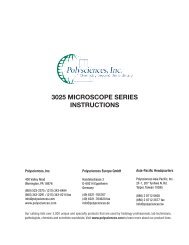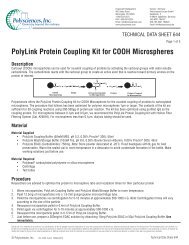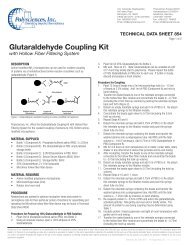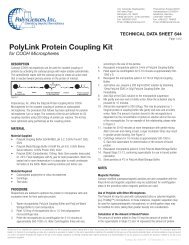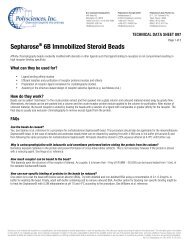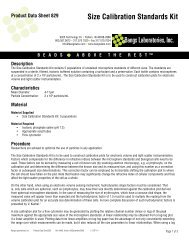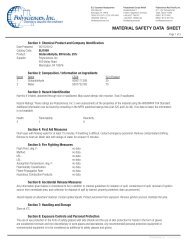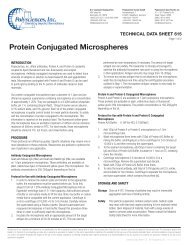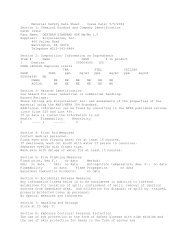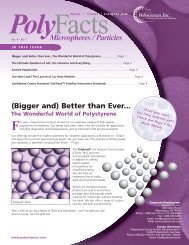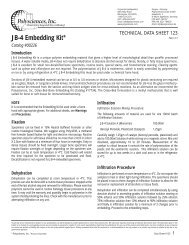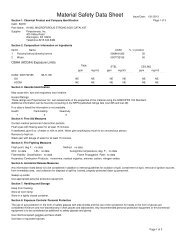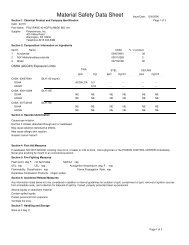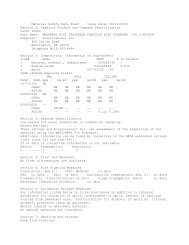Monomers Product Guide - Polysciences, Inc.
Monomers Product Guide - Polysciences, Inc.
Monomers Product Guide - Polysciences, Inc.
Create successful ePaper yourself
Turn your PDF publications into a flip-book with our unique Google optimized e-Paper software.
Catalog #<br />
Size<br />
<strong>Monomers</strong> <strong>Product</strong> <strong>Guide</strong><br />
Acid Containing <strong>Monomers</strong><br />
Acrylic <strong>Monomers</strong><br />
Adhesion Promoting <strong>Monomers</strong><br />
Amine Containing <strong>Monomers</strong><br />
Crosslinking Acrylic <strong>Monomers</strong><br />
Dual Reactive Acrylic <strong>Monomers</strong><br />
Epoxides / Anhydrides / Imides<br />
Fluorescent Acrylic <strong>Monomers</strong><br />
Fluorinated Acrylic <strong>Monomers</strong><br />
High / Low Refractive Index <strong>Monomers</strong><br />
Hydroxy Containing <strong>Monomers</strong><br />
Mono & Difunctional Glycol Oligomeric <strong>Monomers</strong><br />
Styrenic <strong>Monomers</strong><br />
Sulfonate Containing <strong>Monomers</strong><br />
UV Light Active <strong>Monomers</strong><br />
Vinyl & Ethenyl <strong>Monomers</strong><br />
Polymerization Inhibitors for <strong>Monomers</strong><br />
For more information please call (800) 523-2575 or visit: polysciences.com 1
<strong>Monomers</strong><br />
<strong>Monomers</strong><br />
<strong>Polysciences</strong> stocks a wide portfolio of monomers. Such variety offers the synthetic chemist the tools to make a rich array of<br />
polymer compositions. Our <strong>Monomers</strong> Selection <strong>Guide</strong> organizes this set of reactive monomers into various groupings. These<br />
organized sets of data will enable the scientist to quickly determine which specific monomer can be used to synthesize custom<br />
polymers that meet their needs. In reviewing the data in these selection guides, you will be able to compare and contrast<br />
monomer alternatives quickly. More detailed information and chemical structures are included in the alphabetical listing which<br />
follows.<br />
Monomer Selection <strong>Guide</strong> At-A-Glance<br />
Acid Containing <strong>Monomers</strong> ..........................................................................................3<br />
Acid Containing <strong>Monomers</strong>, Metal Salts ...............................................................................3<br />
Acrylic <strong>Monomers</strong> (Neutral, Monofunctional) .........................................................................4<br />
Adhesion Promoting <strong>Monomers</strong> ......................................................................................5<br />
Amine Containing <strong>Monomers</strong> ........................................................................................6<br />
Crosslinking Acrylic <strong>Monomers</strong> - Difunctional .........................................................................7<br />
Crosslinking Acrylic <strong>Monomers</strong> - Multifunctional ......................................................................8<br />
Dual Reactive Acrylic <strong>Monomers</strong> ......................................................................................8<br />
Epoxides / Anhydrides / Imides .......................................................................................9<br />
Fluorescent Acrylic <strong>Monomers</strong>. . . . . . . . . . . . . . . . . . . . . . . . . . . . . . . . . . . . . . . . . . . . . . . . . . . . . . . . . . . . . . . . . . . . . . . . . . . . . . . . . . . . . . . . 10<br />
Fluorinated Acrylic <strong>Monomers</strong> ........................................................................................11<br />
High / Low Refractive Index <strong>Monomers</strong> ...............................................................................11<br />
Hydroxy Containing <strong>Monomers</strong> ......................................................................................12<br />
Mono and Difunctional Glycol Oligomeric <strong>Monomers</strong> .................................................................13<br />
Styrenic <strong>Monomers</strong> ..................................................................................................14<br />
Sulfonate Containing <strong>Monomers</strong> .....................................................................................14<br />
UV (light) Active <strong>Monomers</strong> ..........................................................................................14<br />
Vinyl and Ethenyl <strong>Monomers</strong> .........................................................................................15<br />
Polymerization Inhibitors for <strong>Monomers</strong> ..............................................................................16<br />
2<br />
For more information please call (800) 523-2575 or visit: polysciences.com
<strong>Monomers</strong><br />
Catalog #<br />
Acid Containing <strong>Monomers</strong><br />
Acidic groups are often used to convey solubility to polymers in aqueous media. These moieties can be converted to a wide range of<br />
alternative functional groups. Acid groups can be utilized as catalysts for chemical reactions. Additionally they are employed in polymers<br />
as a functional group which enables improved adhesion to a variety of substrates through hydrogen bonding or metal chelation.<br />
Polymerizable Polymerization<br />
Sites<br />
Synthon Form of Acid Special Features<br />
Acrylic acid min. 99.5% mono acrylic carboxylic acid makes water soluble polymers 00020-250 250 g 128<br />
Acrylic anhydride min. 90% mono acrylic carboxylic acid<br />
(protected)<br />
tert-Butyl methacrylate mono acrylic carboxylic acid<br />
(protected)<br />
Beta-Carboxyethyl acrylate,<br />
>98% Active<br />
Size<br />
not a crosslinker 00488-50 50 g 128<br />
acid formed by thermal<br />
elimination of isobutylene,<br />
homopolymer<br />
Tg = 230° C<br />
02058-100 100 g 134<br />
mono acrylic carboxylic acid high purity, hydrophilic 24891-100 100 g 131<br />
Methacrylic acid, 99.9% mono acrylic carboxylic acid high purity, hydrophilic 24897-250 250 g 147<br />
Methacrylic acid, min. 99.5% mono acrylic carboxylic acid offers latex stability,<br />
homopolymer<br />
Tg =185° C<br />
00212-450 450 g 147<br />
4-Methacryloxyethyl trimellitic<br />
anhydride<br />
mono acrylic anhydride adhesion promoter through<br />
anhydride<br />
Methacryloyl-L-Lysine mono acrylic amino acid zwitterionic, can derivatize<br />
acid or amine<br />
o-Nitrobenzyl methacrylate,<br />
min. 95%<br />
2-Propene-1-sulfonic acid,<br />
sodium salt, 35% soln. in water<br />
2-Sulfoethyl methacrylate,<br />
>90%<br />
mono acrylic carboxylic acid<br />
(protected)<br />
mono vinyl sulfonic acid<br />
salt<br />
mono acrylic sulfonic acid<br />
ester<br />
acid formed by photolabile<br />
deprotection<br />
17285-10 10 g 148<br />
24315-5 5 g 149<br />
24360-10 10 g 151<br />
water soluble 00064-10 10 g 154<br />
water soluble 02597-50 50 g 156<br />
Trichloroacrylic acid mono acrylic carboxylic acid carboxylic acid 02686-10 10 g 157<br />
4-Vinylbenzoic acid mono styrenic carboxylic acid aromatic acid 04485-5 5 g 159<br />
Acid Containing <strong>Monomers</strong>, Metal Salts<br />
Polymerizable<br />
Sites<br />
Polymerization<br />
Synthon Form of Acid Special Features<br />
Barium methacrylate, >95% dual acrylic metal salt metal salt 01994-50 50 g 130<br />
Lead methacrylate<br />
mono acrylic heavy metal salt x-ray opacity and capture 16382-100 100 g 146<br />
2-ethylhexanoate in methyl<br />
methacrylate (0.54/0.46 moles)<br />
Lithium methacrylate mono acrylic metal salt water soluble 17117-50 50 g 146-147<br />
Magnesium acrylate dual acrylic metal salt ionomeric crosslinking, high<br />
Tg polymers<br />
Sodium acrylate mono acrylic metal salt can make high Tg<br />
salt polymers<br />
3-Sulfopropyl acrylate,<br />
potassium salt<br />
3-Sulfopropyl methacrylate,<br />
potassium salt, 98%<br />
mono acrylic sulfonic acid<br />
salt<br />
mono acrylic sulfonic acid<br />
salt<br />
02467-10 10 g 147<br />
01207-50 50 g 155<br />
water soluble 17209-100 100 g 156<br />
water soluble 17210-100 100 g 156<br />
Zinc (di)methacrylate dual acrylic metal salt ionomeric crosslinking 03011-100 100 g 160<br />
For more information please call (800) 523-2575 or visit: polysciences.com 3
<strong>Monomers</strong><br />
Catalog #<br />
Acrylic <strong>Monomers</strong> (Neutral, Monofunctional)<br />
Monofunctional acrylics shape the type and nature of the main chain polymer backbone. <strong>Monomers</strong> are chosen to obtain the desired<br />
glass transition temperature, flexibility, mechanical strength, polarity and hydrophilic/hydrophobic character of the resulting polymer.<br />
Generally, acrylamides exhibit improved resistance to hydrolysis compared to acrylic/methacrylic esters.<br />
Homopolymer<br />
Tg (°C) Special Features<br />
Acrylamide, Chemzymes Ultra Pure ® 165 hydrophilic, hydrogel synthesis 00019-100 100 g 128<br />
N-Acryloylmorpholine 147 hydrophilic 21192-50 50 g 128<br />
Benzhydryl methacrylate high refractive index, aromatic 24286-10 10 g 130<br />
Benzyl acrylate, ~99% 6 high refractive index, aromatic 01997-100 100 g 130<br />
Benzyl methacrylate, min. 95% 54 high refractive index, aromatic 02000-100 100 g 130<br />
N-Benzylmethacrylamide high refractive index, aromatic 17969-25 25 g 130<br />
2-n-Butoxyethyl methacrylate, ~97% moderate polarity 02034-100 100 g 133<br />
tert-Butyl acrylate 43 hydrocarbon building block monomer 02039-250 250 g 133<br />
sec-Butyl acrylate 12 hydrocarbon building block monomer 02038-25 25 g 133<br />
n-Butyl acrylate, min. 99% -54 hydrocarbon building block monomer 02037-500 500 g 133<br />
sec-Butyl methacrylate 60 hydrocarbon building block monomer 02057-10 10 g 133<br />
n-Butyl methacrylate 20 hydrocarbon building block monomer 02059-500 500 g 134<br />
iso-Butyl methacrylate 53 hydrocarbon building block monomer 02056-500 500 g 133<br />
tert-Butyl methacrylate 107 hydrophobic / protected acid 02058-100 100 g 134<br />
4-Chlorophenyl acrylate 58 high refractive index, aromatic 01331-10 10 g 134<br />
Cyclohexyl acrylate, min 85% 19 aliphatic, hydrophobic 02109-100 100 g 135<br />
Cyclohexyl methacrylate, ~98% 83 aliphatic, hydrophobic 01837-100 100 g 135<br />
iso-Decyl acrylate -55 hydrophobic, low Tg 03008-100 100 g 136<br />
n-Decyl methacrylate, 99% -30 hydrophobic 23344-25 25 g 136<br />
iso-Decyl methacrylate, min. 90% hydrophobic 22493-100 100 g 136<br />
N,N-Diethylacrylamide, min. 95% polar building block 00871-25 25 g 137<br />
N,N-Dimethylacrylamide, min. 98% 89 useful for chromatographic resins 02255-100 100 g 138<br />
N,N-Dimethylmethacrylamide<br />
hydrolytic stability,<br />
useful for hydrogels<br />
Size<br />
02270-25 25 g 139<br />
N-Diphenylmethylacrylamide aromatic 19663-5 5 g 139<br />
n-Dodecyl acrylate -3 hydrophobic, long chain alkyl 02460-50 50 g 140<br />
n-Dodecyl methacrylate -55 hydrophobic. Low Tg , long chain alkyl 02461-250 250 g 140<br />
N-Dodecylmethacrylamide 15 hydrophobic, hydrolytic stability 04135-10 10 g 140<br />
2-(2-Ethoxyethoxy)ethyl acrylate -70 02626-100 100 g 140<br />
2-Ethylhexyl acrylate -50 hydrophobic 00587-250 250 g 141<br />
N-Ethylmethacrylamide hydrolytic stability, useful for hydrogels 02322-10 10 g 141<br />
1-Hexadecyl methacrylate 22 hydrophobic, aliphatic 02396-25 25 g 143<br />
n-Hexyl acrylate, min. 98% -45 hydrophobic, aliphatic 02411-100 100 g 144<br />
2-Methoxyethyl acrylate -50 low Tg monomer 02487-100 100 g 148<br />
2-Methoxyethyl methacrylate, min.85% 16 moderate polarity 02488-100 100 g 148<br />
Methyl Methacrylate, min 99.5% 105 versatile building block monomer 00834-1 1 liter 149<br />
2-Naphthyl acrylate 24 fluorescent, hydrophobic, aromatic 06024-1 1 g 150<br />
N-(n-Octadecyl)acrylamide hydrophobic 04673-10 10 g 151<br />
n-Octyl methacrylate -20 hydrophobic 23355-25 25 g 151<br />
N-tert-Octylacrylamide hydrophobic, hydrolytic stability 03141-25 25 g 152<br />
Neopentyl methacrylate hydrophobic 06127-10 10 g 152<br />
Pentabromophenyl acrylate brominated, high RI, flame retardant 06344-10 10 g 152<br />
Pentabromophenyl methacrylate brominated, high RI, flame retardant 04253-5 5 g 152<br />
Pentafluorophenyl acrylate perfluorophenyl, low surface energy 06349-5 5 g 152<br />
Pentafluorophenyl methacrylate, 95% perfluorophenyl, low surface energy 06350-5 5 g 152<br />
4<br />
For more information please call (800) 523-2575 or visit: polysciences.com
<strong>Monomers</strong><br />
Catalog #<br />
Size<br />
Homopolymer<br />
Tg (°C) Special Features<br />
2-Phenoxyethyl methacrylate 54 aromatic, hydrophobic 02640-100 100 g 153<br />
Phenyl acrylate, min. 95% 57 aromatic, UV absorbing 02642-10 10 g 153<br />
Phenyl methacrylate , >95% 110 moderate UV absorbing, aromatic, hydrophobic 02644-10 10 g 153<br />
2-Phenylethyl acrylate, min. 92% -3 moderate UV absorbing, aromatic, hydrophobic 02834-100 100 g 153<br />
2-Phenylethyl methacrylate, min. 92% 26 moderate UV absorbing, aromatic, hydrophobic 02911-100 100 g 153<br />
n-Propyl acrylate -37 building block monomer 03132-25 25 g 155<br />
n-Propyl methacrylate 35 building block monomer 03174-100 100 g 155<br />
N-iso-Propylacrylamide 85 hydrophilic 02455-100 100 g 155<br />
Stearyl acrylate 35 hydrophobic, can form crystal domains 02636-100 100 g 155<br />
Stearyl methacrylate 38 02637-100 100 g 156<br />
Tetrahydrofurfuryl acrylate -12 02907-250 250 g 156<br />
Tribromoneopentyl methacrylate bromo non-aromatic 03057-10 10 g 157<br />
2,4,6-Tribromophenyl acrylate bromo aromatic, high RI 03330-10 10 g 157<br />
Triethylene glycol monomethyl ether<br />
hydrophilic 18556-500 500 g 157<br />
monomethacrylate<br />
3,3,5-Trimethylcyclohexyl methacrylate aliphatic, bulky 02660-100 100 g 158<br />
Undecyl methacrylate hydrophobic 02544-25 25 g 158<br />
Adhesion Promoting <strong>Monomers</strong><br />
Functional groups known to increase adhesion of polymers to surfaces include phosphate and carboxylic acids (metal adhesion)<br />
and silyl ethers (glass/silaceous adhesion) which hydrolyze to give reactive Si-OH bonds. While these monomers are well studied<br />
examples, many monomers having functional groups such as acids, amines and hydroxyls can also impart polymer adhesion to<br />
various substrates. Please refer to other tables for a more expansive listing of these monomers. Also see Amine Monomer section.<br />
Polymerizable<br />
Sites<br />
Polymerization<br />
Synthon<br />
Add’l Reactive<br />
Functionality<br />
Special Features<br />
Acrylic acid min. 99.5% mono acrylic carboxylic acid acid provides metal<br />
adhesion<br />
Bis(2-methacryloxyethyl) phosphate dual acrylic phosphate crosslinking monomer<br />
with adhesion<br />
promoting capabilities,<br />
good for metals<br />
4-Methacryloxyethyl trimellitic<br />
anhydride<br />
mono acrylic anhydride hydrolyzed acid offers<br />
improved adhesion<br />
3-Methacryloxypropyltrimethoxysilane mono acrylic silyl ether ethers react with<br />
silaceous surfaces to<br />
improve adhesion,<br />
glass pretreatment for<br />
polyacrylamide gels<br />
Monoacryloxyethyl phosphate mono acrylic phosphate used for introducing<br />
phosphorus into<br />
polymers, adhesion<br />
promoter<br />
Vinyltriethoxysilane mono vinyl silyl ether reactive silyl ethers<br />
hydrolyze affording<br />
bonding sites to<br />
silaceous surfaces<br />
00020-250 250 g 128<br />
16041-10 10 g 132<br />
17285-10 10 g 148<br />
02476-250 250 g 148<br />
22468-10 10 g 150<br />
04537-50 50 g 160<br />
For more information please call (800) 523-2575 or visit: polysciences.com 5
<strong>Monomers</strong><br />
Catalog #<br />
Amine Containing <strong>Monomers</strong><br />
Amines are among the most widely versatile functional groups. In biopolymers, amines are the key synthetic handle to build structure<br />
and architecture to a polymer. Amine groups can act as base catalysts, can be quaternized to yield aqueous soluble polymers and can<br />
function as ligands to a variety of metals. Amines are good nucleophiles and can be converted to a wide set of functional groups.<br />
Amines can form salts with carboxylic and phosphoric acids to form biologically interesting complexes and structures.<br />
Size<br />
2-Acryloxyethyltrimethylammonium<br />
chloride<br />
2-Aminoethyl methacrylate<br />
hydrochloride, min. 95%<br />
N-(2-aminoethyl) methacrylamide<br />
hydrochloride<br />
N-(t-BOC-aminopropyl)<br />
methacrylamide<br />
N-(3-Aminopropyl)methacrylamide<br />
hydrochloride, >98%<br />
2-(tert-Butylamino)ethyl methacrylate,<br />
min. 90%<br />
Polymerizable<br />
Sites<br />
Polymerization<br />
Synthon<br />
Add’l. Reactive<br />
Functionality<br />
mono acrylic quaternary,<br />
HCI salt<br />
mono acrylic primary,<br />
HCI salt<br />
mono acrylic secondary,<br />
HCI salt<br />
mono acrylic primary<br />
(protected)<br />
mono acrylic primary,<br />
HCI salt<br />
Special Features<br />
solvent soluble,<br />
for primary amine<br />
polymers<br />
mono acrylic secondary homopolymer<br />
Tg = 33º C<br />
17981-250 250 g 128<br />
21002-10 10 g 129<br />
24833-5 5 g 129<br />
24318-10 10 g 129<br />
21200-5 5 g 129<br />
01797-100 100 g 134<br />
Diallylamine, min. 98% dual vinyl secondary forms cyclopolymers 21424-100 100 g 137<br />
Diallyldimethylammonium chloride, dual vinyl quat cationic polymers via 15912-100 100 g 137<br />
65% soln. in water<br />
cyclopolymerization<br />
2-(N,N-Diethylamino)ethyl<br />
methacrylate<br />
2-(Diethylamino)ethylstyrene, mixed<br />
m,p-isomers, min. 95%<br />
mono acrylic tertiary homopolymer<br />
Tg = 20º C<br />
01872-500 500 g 137<br />
mono vinyl tertiary 24100-5 5 g 137<br />
2-Diisopropylaminoethyl methacrylate mono acrylic tertiary 24263-10 10 g 138<br />
2-(N,N-Dimethylamino)ethyl acrylate mono acrylic tertiary 02257-500 500 g 138<br />
N-[2-(N,N-Dimethylamino)ethyl] mono acrylic tertiary hydrolytic stability 06172-5 5 g 138<br />
methacrylamide<br />
N-[3-(N,N-Dimethylamino)propyl]<br />
acrylamide, min.95%<br />
N-[3-(N,N-Dimethylamino)propyl]<br />
methacrylamide<br />
mono acrylic tertiary homopolymer<br />
Tg = 19º C<br />
22018-10 10 g 138<br />
mono acrylic tertiary hydrolytic stability 09656-100 100 g 139<br />
3-Dimethylaminoneopentyl acrylate mono acrylic tertiary 17970-10 10 g 139<br />
2-(N,N-Dimethylamino)ethyl<br />
mono acrylic tertiary homopolymer 00213-500 500 g 138<br />
methacrylate, min. 99%<br />
Tg = 19º C<br />
Methacryloyl-L-Lysine mono acrylic amino acid zwitterionic,<br />
multifunctional,<br />
water soluble<br />
24315-5 5 g 149<br />
2-N-Morpholinoethyl acrylate, 95% mono acrylic tertiary 17977-100 100 g 150<br />
2-N-Morpholinoethyl methacrylate, mono acrylic tertiary 17978-100 100 g 150<br />
95%<br />
6<br />
For more information please call (800) 523-2575 or visit: polysciences.com
<strong>Monomers</strong><br />
Catalog #<br />
Crosslinking Acrylic <strong>Monomers</strong> - Difunctional<br />
Difunctional monomers are useful for imparting crosslinking or branching sites to polymer architectures. The “spacer” group between<br />
the acrylic end groups often helps determine the physical and mechanical attributes of the resulting crosslinked polymer structure.<br />
Acrylic moieties are generally more reactive than methacrylic moieties and are thus used when faster reaction kinetics are desired<br />
(e.g. UV curable systems.)<br />
Add’l. Reactive<br />
Functionality Special Features<br />
1-(Acryloyloxy)-3-(Methacryloyloxy)-2-Propanol hydroxyl 25351-50 50 ml 129<br />
Barium methacrylate, >95% carboxylic acid divalent metal atom salt 01994-50 50 g 130<br />
2,2-Bis[4-(2-acryloxyethoxy)phenyl]propane<br />
rigid hydrophibic,<br />
crosslinker<br />
Size<br />
rigid, aromatic 04136-25 25 g 131<br />
2,2-Bis[4-(2-hydroxy-3-methacryloxypropoxy)phenyl]propane rigid, aromatic 03344-100 100 g 131<br />
Bis(2-methacryloxyethyl) N,N’-1,9-nonylene biscarbamate flexible, hydrophobic 21619-50 50 g 131<br />
Bis(2-methacryloxyethyl) phosphate phosphate adhesion promoter 16041-10 10 g 132<br />
2,2-Bis(4-methacryloxyphenyl)propane rigid, hydrophobic 01381-25 25 g 132<br />
1,4-Butanediol diacrylate, min. 85% aliphatic 02049-100 100 g 132<br />
1,3-Butanediol dimethacrylate, 98% aliphatic 02047-500 500 g 132<br />
1,4-Butanediol dimethacrylate, min. 90% aliphatic 05973-250 250 g 133<br />
Copper (II) methacrylate carboxylic acid divalent metal atom salt 21222-25 25 g 135<br />
trans-1,4-Cyclohexanediol dimethacrylate rigid, aliphatic 18912-10 10 g 135<br />
N,N’-Cystaminebisacrylamide, Electro Pure disulfide reversible crosslinking 09809-5 5 g 135<br />
1,10-Decanediol dimethacrylate flexible, aliphatic, long chain 02140-25 25 g 136<br />
1,4-Diacryloylpiperazine rigid 21190-10 10 g 136<br />
N,N-Diallylacrylamide acrylic 01848-10 10 g 136<br />
Diethylene glycol diacrylate hydrophilic 02215-100 100 g 137<br />
Diethylene glycol dimethacrylate hydrophilic 02214-100 100 g 138<br />
2,2-Dimethylpropanediol dimethacrylate aliphatic 02276-100 100 g 139<br />
N, N’ Ethylene Bisacrylamide hydrogel crossslinker 09811-1 1 g 140<br />
Ethylene glycol diacrylate UV curable, acrylate 02302-25 25 g 140<br />
Ethylene glycol dimethacrylate, 99.7% hydrophilic, high purity 24896-250 250 g 141<br />
Ethylene glycol dimethacrylate, min 88% hydrophilic 02303-250 250 g 141<br />
Ethylene glycol dimethacrylate, min 98% hydrophilic 24030-250 250 g 141<br />
Fluorescein dimethacrylate fluorescent 23589-100 100 mg 141<br />
N,N’-Hexamethylenebisacrylamide hydrolytic stability 01495-5 5 g 143<br />
1,6-Hexanediol diacrylate aliphatic 23671-100 100 g 144<br />
1,6-Hexanediol dimethacrylate, min 98% aliphatic 23672-100 100 g 144<br />
2,2-Bis[4-(2-hydroxy-3-methacryloxypropoxy)phenyl]propane rigid, aromatic 03344-500 500 g 144<br />
Lead acrylate 02968-100 100 g 146<br />
Magnesium acrylate carboxylic acid divalent metal atom salt 02467-10 10 g 147<br />
N,N’-Methylenebisacrylamide,<br />
hydrogel crosslinker 00719-100 100 g 149<br />
Chemzymes ® ; Ultra Pure, Purity >99%<br />
1,9-Nonanediol dimethacrylate flexible, aliphatic 00801-10 10 g 151<br />
1,5-Pentanediol dimethacrylate aliphatic 04260-25 25 g 152<br />
1,4-Phenylene diacrylate rigid, aromatic 06389-10 10 g 153<br />
Tetraethylene glycol dimethacrylate aliphatic 02654-50 50 g 156<br />
Tricyclodecane dimethanol diacrylate 25110-50 50 g 157<br />
Triethylene glycol diacrylate UV curable, acrylate > methacrylate 02655-250 250 g 157<br />
Triethylene glycol dimethacrylate 01319-250 250 g 157<br />
Triethylene glycol dimethacrylate, min 95% aliphatic 24034-100 100 g 157<br />
Zinc (di)methacrylate carboxylic acid ionomeric crosslinker 03011-100 100 g 160<br />
For more information please call (800) 523-2575 or visit: polysciences.com 7
<strong>Monomers</strong><br />
Catalog #<br />
Crosslinking Acrylic <strong>Monomers</strong> - Multifunctional<br />
Typically used for generating highly crosslinked polymer structures, these monomers increase polymer toughness, modulus and solvent<br />
resistance. For UV curable formulations, multifuntional acrylates are typically faster reacting than their methacrylate analogs.<br />
Dipentaerythritol pentaacrylate<br />
(mixture of tetra-, penta-, hexaacrylate)<br />
Polymerizable<br />
Sites<br />
Add’l. Reactive<br />
Functionality Special Features<br />
multiple high crosslinking efficiency 16311-500 500 g 139<br />
Pentaerythritol tetraacrylate multiple 01547-100 100 g 152<br />
Pentaerythritol triacrylate tri hydroxyl multifunctional crosslinker 04259-100 100 g 152<br />
1,1,1-Trimethylolpropane triacrylate tri useful for UV cure 02658-250 250 g 158<br />
1,1,1-Trimethylolpropane trimethacrylate tri useful for UV cure 02659-250 250 g 158<br />
Size<br />
Dual Reactive Acrylic <strong>Monomers</strong><br />
It is often desirable to synthesize polymer architectures that are capable of further reaction to incorporate new functionality, graft new<br />
polymer chains, attach drugs or biomolecules, or make the polymer respond intelligently to changes in its environment. This diverse set<br />
of monomers have easily polymerizable carbon-carbon double bonds yet contain a secondary reactive group that can be elaborated in a<br />
multitude of ways. Some reactive groups e.g., carboxylic acid in o-nitrobenzyl methacrylate (Cat. #24360) are masked and are revealed<br />
by simple deprotection schemes.<br />
Add’l. Reactive<br />
Functionality<br />
Special Features<br />
Acrylic anhydride min. 90% anhydride (protected) allows formation of cyclic anhydrides 00488-50 50 g 128<br />
4-(2-Acryloxyethoxy)-2-<br />
hydroxybenzophenone<br />
phenol<br />
benzophenone is a strong UV absorber,<br />
potential UV radical initiator<br />
N-Acryloxysuccinimide ester (protected) derivitization through ester link using mild<br />
reaction conditions, good for biologically<br />
active compounds<br />
Allyl methacrylate olefin allyl double bond is less reactive than<br />
methacrylate, good for post polymerization<br />
reactions<br />
2-Aminoethyl methacrylate hydrochloride,<br />
min. 95%<br />
amine (as HCl salt)<br />
can be used to prepare polymers with amine<br />
functionality<br />
N-(t-BOC-aminopropyl)methacrylamide amine (protected) t-BOC easily deprotected to yield primary<br />
amine<br />
N-(3-Aminopropyl)methacrylamide<br />
hydrochloride, >98%<br />
amine (as HCl salt)<br />
can be used to prepare polymers with amine<br />
functionality<br />
2-Bromoethyl acrylate, min. 95% halogen allows synthesis of heavy atom polymers, Br<br />
can be displaced with various nucleophiles<br />
N-(iso-Butoxymethyl)methacrylamide,<br />
min. 95%<br />
tert-Butyl acrylate<br />
2-(tert-Butylamino)ethyl methacrylate,<br />
min. 90%<br />
19931-10 10 g 128<br />
19930-1 1 g 128<br />
01643-500 500 g 129<br />
21002-10 10 g 129<br />
24318-10 10 g 129<br />
21200-5 5 g 129<br />
02015-10 10 g 132<br />
oxo-methylene acid + heat catalyzed crosslinking monomer 19221-100 100 g 133<br />
carboxylic acid<br />
(protected)<br />
amine (secondary)<br />
used in photoresist formulations 02039-250 250 g 133<br />
builds polymers with secondary amines,<br />
potential H-Bonding sites<br />
01797-100 100 g 134<br />
2-Carboxyethyl acrylate, 90% carboxylic acid lower volatility analog to acrylic acid 16719-100 100 g 134<br />
2-Cinnamoyloxyethyl acrylate a, b unsat. ester photocrosslinking monomer 24014-10 10 g 135<br />
Cinnamyl methacrylate functionalized styrene photocrosslinking monomer 02092-5 5 g 135<br />
2-Cyanoethyl acrylate nitrile polar building block monomer, can use nitrile<br />
for functionalization<br />
01829-100 100 g 135<br />
N,N-Diallylacrylamide allyl crosslinking monomer 01848-10 10 g 136<br />
Dicyclopentenyloxyethyl acrylate ethenyl endo cyclic olefin does not readily polymerize, 15797-25 25 g 137<br />
can be post reacted e.g. oxidative crosslinking<br />
Glycerol monomethacrylate,<br />
mixture of isomers<br />
hydroxyl<br />
isomer mixture, useful in hydrogel<br />
preparation,-OH can be functionalized in<br />
multiple ways<br />
04180-25 25 g 141<br />
8<br />
For more information please call (800) 523-2575 or visit: polysciences.com
<strong>Monomers</strong><br />
Catalog #<br />
Size<br />
Add’l. Reactive<br />
Functionality<br />
Special Features<br />
Glycidyl methacrylate epoxide versatile, introduces reactive sites into<br />
polymers, can be derivatized in post<br />
polymerization reactions with various<br />
nucleophiles<br />
02607-500 500 g 142<br />
2-Hydroxyethyl acrylate hydroxyl hydrophilic monomer building block 01902-250 250 g 144<br />
Hydroxypropyl methacrylate,<br />
hydroxyl<br />
hydrophilic monomer building block, can be 00730-500 500 g 146<br />
mixture of isomers<br />
post reacted through hydroxyl<br />
N-(2-Hydroxypropyl)methacrylamide hydroxyl hydrophilic monomer building block, can be<br />
post reacted through hydroxyl group<br />
3-Methacryloxypropyltrimethoxysilane silyl ether ethers react with glass surfaces to<br />
improve adhesion, glass pretreatment for<br />
polyacrylamide gels<br />
Methacryloyl chloride,<br />
min. 80%<br />
halogen<br />
reactive building block monomer. Also used to<br />
prepare other specialty monomers<br />
Methacryloyl fluoride halogen reactive building block monomer. Also used to<br />
prepare other specialty monomers<br />
08242-10 10 g 145<br />
02476-250 250 g 148<br />
01518-50 50 g 148<br />
17414-25 25 g 149<br />
Methyl 2-cyanoacrylate cyano used in rapidly setting cements and adhesives 01520-10 10 g 149<br />
N-Methylolacrylamide,<br />
acid catalyzed post polymerization crosslinking 02518-250 250 g 149<br />
48% soln. in water<br />
capabilities<br />
Monoacryloxyethyl phosphate phosphate used for introducing phosphorus into<br />
polymers, adhesion promoter<br />
o-Nitrobenzyl methacrylate,<br />
min. 95%<br />
carboxylic acid<br />
(protected)<br />
nitrobenzyl ester removed by UV irradiation<br />
to afford carboxylic acid, used for catalysis,<br />
photoresists, latent reactive acid<br />
22468-10 10 g 150<br />
24360-10 10 g 151<br />
N-(Phthalimidomethyl)acrylamide active methylene used in photoresist formulations 19390-25 25 g 153<br />
Propargyl acrylate acetylenic acetylenic group can be post functionalized, 02964-25 25 g 154<br />
possible oxidative crosslinking monomer<br />
Propargyl methacrylate acetylenic acetylenic group can be post functionalized,<br />
possible oxidative crosslinking monomer<br />
02965-25 25 g 154<br />
Tricyclodecane dimethanol diacrylate 25110-50 50 g 157<br />
Epoxides / Anhydrides / Imides<br />
Unlike ethylenic monomers which polymerize through free radical processes, epoxide resins react with amines, carboxylic acids,<br />
anhydrides, etc. to form polymers displaying a range of characteristics from tough and durable to soft and adhesive.<br />
Polymerizable Sites Special Features<br />
Allyl glycidyl ether mono can react either epoxide or allyl group into<br />
polymers<br />
4,4’-Bisphenol A Bis-(N-Methylphthalimide) dual useful monomer for synthesis of high temp.<br />
polymers<br />
4,4’-Bisphenol A Dianhydride dual useful monomer for synthesis of high temp.<br />
polymers<br />
1,4-Butanediol diglycidyl ether dual can be used for post polymerization<br />
crosslinking of amine polymers<br />
Citraconic anhydride mono reversible protection of amino groups in<br />
protein synthesis<br />
Glycidyl butyl ether mono used in epoxy reactions as monofunctional<br />
diluent<br />
Glycidyl cinnamate mono polymerizable with various carboxylic acids,<br />
alcohols and amines; Olefin moiety can be<br />
photocrosslinked<br />
Glycidyl Glycerol-Ether, Polyfunctional multiple isomer mixture, efficient crosslinking<br />
monomer for various nucleophilic agents<br />
19191-50 50 g 129<br />
24284-25 25 g 132<br />
24283-25 25 g 132<br />
01795-50 50 g 132<br />
01824-100 100 g 135<br />
05678-500 500 g 141<br />
16090-10 10 g 142<br />
09221-50 50 g 142<br />
For more information please call (800) 523-2575 or visit: polysciences.com 9
<strong>Monomers</strong><br />
Catalog #<br />
Size<br />
Polymerizable Sites Special Features<br />
Glycidyl nonylphenyl ether mono epoxy functional 18236-100 100 g 142<br />
Methacrylic anhydride uncrosslinked 01517-100 100 ml 147<br />
Ethylene glycol diglycidyl ether (Quetol 651) dual active crosslinking monomer for active<br />
nucelophiles, hydrophilic, used for hydrogels<br />
01479-100 100 g 141<br />
Propylene Oxide, EM Grade mono basic bulding block monomer for water<br />
dispersible polymers<br />
Propylene glycol diglycidyl ether dual versatile crosslinker for amine, hydroxyl and<br />
carboxylate systems<br />
Triglycidyl isocyanurate tri crosslinking monomer for epoxy, urethane<br />
systems<br />
00236-1 1 pint 155<br />
24044-100 100 g 155<br />
16173-50 50 g 158<br />
Fluorescent Acrylic <strong>Monomers</strong><br />
<strong>Monomers</strong> with fluorescent tags are often used to build polymers that can be detected at very low concentrations using fluorescence<br />
spectroscopy. Polymer migration and diffusion has been studied using fluorescent tags. Polymer microspheres containing fluorescent<br />
groups are used routinely for flow cytometry and medical diagnostic assays.<br />
Monomer Type<br />
Special Features<br />
9-Anthracenylmethyl methacrylate neutral Ex. max = 362 nm, Em. max = 407 nm,<br />
yellow crystals<br />
neutral<br />
Ex. max = 362 nm, Em. max = 407 nm,<br />
yellow crystals<br />
3,8-dimethacryloyl ethidium bromide ionic Ex. max = 439 nm, Em. max = 512 nm,<br />
insoluble in water<br />
23587-100 100 mg 130<br />
23587-1 1 g 130<br />
23590-100 100 mg 138<br />
Fluorescein dimethacrylate neutral Ex. max = 470 nm, Em. = 511 nm 23589-100 100 mg 141<br />
Methacryloxyethyl thiocarbamoyl<br />
ionic, mixture isomers Ex. max = 548 nm, Em. max = 570 nm,<br />
23591-100 100 mg 147<br />
rhodamine B<br />
purple crystals<br />
2-Naphthyl acrylate neutral hydrophobic, fluorescent monomer 06024-1 1 g 150<br />
2-Naphthyl methacrylate neutral Ex. max = 285 nm, Em. min = 345 nm 23602-100 100 mg 150<br />
Nile Blue Acrylamide dark blue crystals; Em. Max. 674 nm in H 2<br />
O 25395-100 100 mg 150<br />
Nile Blue Methacrylamide dark purple crystals; Em. Max. 674 nm in H 2<br />
O 25355-100 100 mg 151<br />
O-Methacryloyl Hoechst 33258 neutral Ex. max = 355 nm , Em. max = 497 nm,<br />
off-white crystals<br />
1-Pyrenylmethyl methacrylate neutral Ex. max = 339 nm, Em. min = 394 nm,<br />
pale yellow crystals<br />
23592-100 100 mg 148<br />
23588-100 100 mg 155<br />
10<br />
For more information please call (800) 523-2575 or visit: polysciences.com
<strong>Monomers</strong><br />
Catalog #<br />
Fluorinated Acrylic <strong>Monomers</strong><br />
<strong>Monomers</strong> containing fluorine provide polymers with unique low energy surfaces. Materials made from these monomers are typically<br />
chemical resistant and very hydrophobic.<br />
Homopolymer<br />
Tg (°C)<br />
Bis-(2,2,2-Trifluoroethyl) Itaconate 24972-25 25 g 131<br />
Bis-(1,1,1,3,3,3-Hexafluoroisopropyl) Itaconate 24971-25 25 g 131<br />
1H,1H,7H-Dodecafluoroheptyl methacrylate 13 00767-25 25 g 140<br />
1H,1H,2H,2H-Heptadecafluorodecyl acrylate 0 19227-100 100 g 142<br />
1H,1H,2H,2H-Heptadecafluorodecyl methacrylate 40 19226-25 25 g 143<br />
1H,1H-Heptafluorobutyl acrylate -30 21039-25 25 g 143<br />
Hexafluoro-iso-propyl methacrylate 02401-10 10 g 143<br />
1H,1H,3H-Hexafluorobutyl acrylate -22 05631-10 10 g 143<br />
1H,1H,3H-Hexafluorobutyl methacrylate 05632-10 10 g 143<br />
1,1,1,3,3,3-Hexafluoroisopropyl Acrylate 24970-25 25 g 143<br />
1H,1H,5H-Octafluoropentyl acrylate -35 21044-25 25 g 151<br />
1H,1H,5H-Octafluoropentyl methacrylate, min. 98% 36 21045-25 25 g 151<br />
Pentafluorophenyl acrylate 06349-5 5 g 152<br />
Pentafluorophenyl methacrylate, 95% 06350-5 5 g 152<br />
1H,1H,3H-Tetrafluoropropyl methacrylate 07577-25 25 g 156<br />
2,2,2-Trifluoroethyl acrylate -10 01718-25 25 g 157<br />
2,2,2-Trifluoroethyl methacrylate 80 02622-25 25 g 157<br />
Size<br />
High/Low Refractive Index <strong>Monomers</strong><br />
Polymers that interact with light can be modified by optimizing their refractive index properties. These materials are useful in many<br />
types of optical applications: lenses, optical switches, optical fiber coatings, etc. Low RI monomers are typically highly fluorinated.<br />
Polymers using perfluorinated monomers are often hydrophobic and exhibit very low surface energies.<br />
Polymerizable<br />
Sites<br />
Homopolymer<br />
Tg (°C)<br />
Special Features<br />
Allyl Phenyl Ether, 98% vinyl hydrophobic, high RI (ca 1.52) 24894-100 100 g 129<br />
Benzyl acrylate, ~99% acrylic 6 high RI (ca 1.55), non-halogenated 01997-100 100 g 130<br />
Benzyl methacrylate, min. 95% acrylic 54 high RI (ca 1.57), non-halogenated 02000-100 100 g 130<br />
N-Benzylmethacrylamide acrylic high RI (ca 1.60), non-halogenated 17969-25 25 g 130<br />
2-(9H-Carbazole-9-yl) ethyl methacrylate acrylic high RI (ca 1.69) 24372-1 1 g 134<br />
4-Chlorophenyl acrylate acrylic 58 high RI (ca 1.55), chlorinated aromatic 01331-10 10 g 134<br />
3-Chlorostyrene, 98% 90 high RI (ca 1.57) 02042-5 5 g 135<br />
1H,1H,7H-Dodecafluoroheptyl<br />
methacrylate<br />
1H,1H,2H,2H-Heptadecafluorodecyl<br />
acrylate<br />
1H,1H,2H,2H-Heptadecafluorodecyl<br />
methacrylate<br />
acrylic 13 low RI (ca 1.36), fluorinated aliphatic 00767-25 25 g 140<br />
acrylic 0 low RI (ca 1.34), fluorinated 19227-25 25 g 142<br />
acrylic 40 low RI (ca 1.35), fluorinated 19226-25 25 g 143<br />
1H,1H-Heptafluorobutyl acrylate acrylic -30 low RI (ca 1.37), fluorinated 21039-25 25 g 143<br />
Hexafluoro-iso-propyl methacrylate acrylic low RI (ca 1.38), fluorinated 02401-10 10 g 143<br />
1H,1H,3H-Hexafluorobutyl acrylate acrylic -22 low RI (ca 1.39), fluorinated 05631-10 10 g 143<br />
1H,1H,3H-Hexafluorobutyl methacrylate acrylic low RI (ca 1.40), fluorinated 05632-10 10 g 143<br />
1H,1H,5H-Octafluoropentyl acrylate acrylic -35 low RI (ca 1.38), fluorinated 21044-25 25 g 151<br />
1H,1H,5H-Octafluoropentyl methacrylate, acrylic 36 low RI (ca 1.39), fluorinated 21045-25 25 g 151<br />
min. 98%<br />
Pentabromophenyl acrylate acrylic high RI (ca 1.7), brominated aromatic 06344-10 10 g 152<br />
Pentabromophenyl methacrylate acrylic high RI (ca 1.7), brominated aromatic 04253-5 5 g 152<br />
For more information please call (800) 523-2575 or visit: polysciences.com 11
<strong>Monomers</strong><br />
Catalog #<br />
Size<br />
Polymerizable<br />
Sites<br />
Homopolymer<br />
Tg (°C)<br />
Special Features<br />
1H,1H,3H-Tetrafluoropropyl methacrylate acrylic low RI (ca 1.4), fluorinated aliphatic 07577-25 25 g 156<br />
2,4,6-Tribromophenyl acrylate acrylic high RI (ca 1.6), brominated aromatic 03330-10 10 g 157<br />
2,2,2-Trifluoroethyl acrylate acrylic -10 low RI (ca 1.44), fluorinated aliphatic 01718-25 25 g 157<br />
2,2,2-Trifluoroethyl methacrylate acrylic 80 low RI (ca 1.41), fluorinated aliphatic 02622-25 25 g 157<br />
N-Vinylcarbazole vinyl high RI (ca 1.68) 02429-25 25 g 159<br />
Hydroxy Containing <strong>Monomers</strong><br />
Hydroxyl groups have utility as hydrogen bonding sites and can provide polymers with compatibility for water or polar solvents.<br />
These versatile functional groups can be derivitized broadly. Polymers containing free –OH groups can be post reacted with acids,<br />
epoxies, isocyanates, etc. to create novel polymer properties and architectures.<br />
4-(2-Acryloxyethoxy)-2-<br />
hydroxybenzophenone<br />
Polymerizable<br />
Sites<br />
Polymerizable<br />
Synthon<br />
Add’l.<br />
Reactive<br />
Functionality Special Features<br />
mono acrylic phenol UV absorbing, aromatic 19931-10 10 g 128<br />
4-tert-Butoxystyrene, min. 99% mono styrene phenol (protected) deprotect with heat 21760-10 10 g 133<br />
Glycerol monomethacrylate, mono acrylic hydroxyl useful for hydrogels 04180-25 25 g 141<br />
mixture of isomers<br />
(HEMA 10) Poly Ethoxy (10)<br />
ethyl methacrylate<br />
mono acrylic hydroxyl hydrophilic 24890-100 100 g 142,<br />
153<br />
2-Hydroxyethyl acrylate mono acrylic hydroxyl homopolymer Tg = 15° C 01902-250 250 g 144<br />
Hydroxypolyethoxy (10)<br />
mono vinyl hydroxyl hydrophilic 24899-100 100 g 145<br />
Allyl Ether, 98%<br />
N-(2-Hydroxypropyl)<br />
methacrylamide<br />
Hydroxypropyl methacrylate,<br />
mixture of isomers<br />
Poly(propylene glycol) (300)<br />
monomethacrylate<br />
Sodium 1-Allyloxy-2<br />
hydroxypropyl Sulfonate<br />
1,1,1-Trimethylolpropane<br />
diallyl ether<br />
1,1,1-Trimethylolpropane<br />
monoallyl ether<br />
mono acrylic hydroxyl hydrolytic stability 08242-10 10 g 145<br />
mono acrylic hydroxyl aliphatic 00730-1 1 kg 146<br />
mono acrylic hydroxyl slightly hydrophilic,<br />
long chain graft<br />
15934-250 250 g 154<br />
sulfonate salt 24898-100 100 g 155<br />
mono vinyl hydroxyl hydrophilic crosslinker 05500-50 50 g 158<br />
mono vinyl hydroxyl hydrophilic crosslinker 15914-50 50 g 158<br />
12<br />
For more information please call (800) 523-2575 or visit: polysciences.com
<strong>Monomers</strong><br />
Catalog #<br />
Mono and Difunctional Glycol Oligomeric <strong>Monomers</strong><br />
Ethylene glycol units are strongly hydrophilic through their multiple H-bonding sites. <strong>Monomers</strong> of this type are useful in the construction<br />
of hydrogels and water compatible polymer structures. New research suggests that bioactive molecules e.g. drugs with attached PEG<br />
chains have improved bioavailablity characteristics.<br />
Size<br />
Poly(ethylene glycol)<br />
diacrylate<br />
Poly(ethylene glycol)<br />
dimethacrylate<br />
Poly(ethylene glycol)<br />
monomethacrylate<br />
Poly(ethylene glycol)<br />
monomethyl ether<br />
monomethacrylate<br />
Poly(propylene glycol)<br />
monomethacrylate<br />
Poly(propylene glycol)<br />
dimethacrylate<br />
Polymerizable<br />
Synthon (Sites)<br />
Add’l<br />
Reactive<br />
Group<br />
Approx. #<br />
of Glycol<br />
Groups<br />
Approx.<br />
MW.<br />
Special Features<br />
acrylic (2) none 4 to 6 314 hydrophilic crosslinking monomer 00669-250 250 g 153<br />
acrylic (2) none 8 to 10 500 01871-250 250 g 153<br />
acrylic (2) none 90 to 100 4,100 15246-1 1 g 153<br />
methacrylic (2) none 4 to 6 350 hydrophilic crosslinking monomer 00096-100 100 g 154<br />
methacrylic (2) none 8 to 10 550 15179-100 100 g 154<br />
methacrylic (2) none 13 to 15 750 02364-100 100 g 154<br />
methacrylic (2) none 21 to 25 1,150 15178-100 100 g 154<br />
methacrylic (1) hydroxy 4 to 6 270 long chain monomer, more<br />
polar than PO analog, can post<br />
react -OH to add additonal<br />
functionality<br />
16712-100 100 g 154<br />
methacrylic (1) hydroxy 8 to 10 480 16713-100 100 g 154<br />
methacrylic (1) none 4 to 6 280 adds hydrophilic grafts to 16664-100 100 g 124<br />
polymers; adds long chain<br />
hydrophilic graft to polymer chain<br />
methacrylic (1) none 8 to 10 490 16665-100 100 g 124<br />
methacrylic (1) none 21 to 25 1,090 16666-100 100 g 124<br />
methacrylic (1) hydroxy 3 to 5 440 propylene glycol is more<br />
hydrophobic than ethylene glycol<br />
long chain monomer, can post<br />
react -OH to add functionality<br />
15934-250 250 g 154<br />
methacrylic (2) none 5 to 7 550 less polar than EO analog 04380-250 250 g 154<br />
For more information please call (800) 523-2575 or visit: polysciences.com 13
Catalog #<br />
Styrenic <strong>Monomers</strong><br />
Popular alternatives to acrylic and related monomers, styrenic monomers generally provide polymers of higher glass transition<br />
temperature, higher modulus, increased hydrophobic character and nominal UV absorbance. As such, coatings made with<br />
high concentrations of styrenic monomers can yellow with time if exposed to UV light. Crosslinked styrene resins (especially<br />
in microsphere form) are tough and chemically resistant. These form the basis for ion exchange resins and microbeads used<br />
as supports for biochemical reactions.<br />
4-tert-Butoxystyrene, min. 99%<br />
Monomer<br />
Type<br />
protected<br />
group<br />
Add’l. Reactive<br />
Functionality<br />
Homopolymer<br />
Tg (ºC) Special Features<br />
phenol deprotection gives phenol 21760-10 10 g 133<br />
4-(tert-Butyl)styrene, 95% neutral 132 high Tg monomer 02606-25 25 g 134<br />
4-Chloromethylstyrene reactive halogen Merrifield resin building block 22193-25 25 g 134<br />
Chloromethylstyrene, 43% reactive halogen Merrifield resin building block 02718-500 500 g 134<br />
para, 57% meta, ~96%<br />
3-Chlorostyrene, 98% 90 02042-5 5 g 135<br />
2-(Diethylamino)ethylstyrene,<br />
24100-5 5 g 137<br />
mixed m,p-isomers, min. 95%<br />
Divinylbenzene<br />
(50 - 60% Active)<br />
<strong>Monomers</strong><br />
Size<br />
01892-100 100 g 140<br />
Divinylbenzene (80% Active) neutral vinyl aromatic, rigid crosslinker 22478-100 100 g 140<br />
4-Methylstyrene neutral 108 aromatic, hydrophobic 04234-100 100 g 150<br />
2-Methylstyrene neutral 120 aromatic, hydrophobic 04581-5 5 g 149<br />
4-Nitrostyrene reactive nitro nitro can be reduced to amine 02634-5 5 g 151<br />
Styrene neutral 100 00660-500 500 g 156<br />
4-Vinylbenzoic acid reactive carboxylic acid versatile -COOH synthesis handle 04485-5 5 g 159<br />
Sulfonate Containing <strong>Monomers</strong><br />
Polymerizable Polymerization<br />
Special<br />
Sites<br />
Synthon<br />
Form of Acid Features<br />
2-Sulfoethyl methacrylate, >90% mono acrylic sulfonic acid water soluble 02597-50 50 g 156<br />
3-Sulfopropyl methacrylate,<br />
potassium salt, 98%<br />
3-Sulfopropyldimethyl-3-<br />
methacrylamidopropylammonium,<br />
inner salt<br />
mono acrylic sulfonic acid<br />
salt<br />
water soluble 17210-100 100 g 156<br />
Zwitterionic<br />
detergent and<br />
crosslinker.<br />
16570-5 5 g 156<br />
UV (light) Active <strong>Monomers</strong><br />
Polymers with aliphatic backbones often show little absorbance of light and usually do not absorb in the near and mid UV spectral range.<br />
UV absorbing monomers improve the capture of light at these wavelengths. These absorbers can be used to shield the polymer system<br />
or an underlying substrate from degradation by UV light, e.g. phenethyl methacrylate containing polymers for optical lenses. Additionally,<br />
some UV absorbing materials can act as sensitizers to promote photochemical reactions.<br />
2(5-Benzotriazolyl 3-t-butyl<br />
4-methacryloxy)phenyl propionic acid,<br />
isooctyl ester<br />
Polymerization<br />
Synthon<br />
Add’l.<br />
Reactive<br />
Functionality<br />
Homopolymer<br />
Tg (ºC) Special Features<br />
acrylic UV absorber 24241-1 1 g 130<br />
2-Cinnamoyloxyethyl acrylate acrylic a,b unsat. photo reactive ester 24014-10 10 g 135<br />
Cinnamyl methacrylate acrylic a,b unsat. photo reactive ester 02092-5 5 g 135<br />
Glycidyl cinnamate epoxide ethenyl photo reactive 16090-10 10 g 142<br />
14<br />
For more information please call (800) 523-2575 or visit: polysciences.com
<strong>Monomers</strong><br />
Catalog #<br />
Size<br />
2-(2’-Methacryloxy-5’-methylphenyl)<br />
benzotriazole<br />
2-(2’-Hydroxy-5’-methylphenyl)-<br />
benzotriazole<br />
Polymerization<br />
Synthon<br />
Add’l.<br />
Reactive<br />
Functionality<br />
Homopolymer<br />
Tg (ºC) Special Features<br />
acrylic UV absorber 21871-25 25 g 148<br />
none UV absorber 21363-25 25 g 144<br />
Phenyl acrylate, min. 95% acrylic 57 UV absorbing 02642-10 10 g 153<br />
Phenyl methacrylate , >95% acrylic 110 moderate UV<br />
02644-10 10 g 153<br />
absorbing<br />
2-Phenylethyl acrylate, min. 92% acrylic -3 moderate UV<br />
absorbing, aromatic,<br />
hydrophobic<br />
2-Phenylethyl methacrylate, min. 92% acrylic 26 moderate UV<br />
absorbing<br />
N-(Phthalimidomethyl)acrylamide acrylic used in photoresist<br />
formulations<br />
02834-100 100 g 153<br />
02911-100 100 g 153<br />
19390-25 25 g 153<br />
Vinyl and Ethenyl <strong>Monomers</strong><br />
An alternative choice to styrenics and acrylics, these monomers are often used to create polymers with inert main chain features.<br />
Many of these monomers can be polymerized via metallocene or other metal mediated polymerization processes.<br />
Polymerizable<br />
Sites<br />
Add’l. Reactive<br />
Functionality<br />
Special Features<br />
Acrolein, distilled, 99% EM grade mono aldehyde 00016-5 5x10 ml 128<br />
Allyl glycidyl ether mono epoxide 19191-50 50 g 129<br />
2,2-Bis[4-(2-acryloxyethoxy)phenyl]<br />
propane<br />
dual rigid crosslinker 04136-25 25 g 131<br />
3-Butene-1,2,3-tricarboxylic acid mono 01396-25 25 g 133<br />
Diallyl Maleate dual vinyl vinyl hydrophilic 02156-250 250 g 136<br />
Diallyl Maleate - 99% Active dual vinyl vinyl hydrophilic 24892-100 100 g 136<br />
Diallyl phthalate, practical dual 02159-1 1 kg 136<br />
Diallylamine, min. 98% dual amine (secondary) 21424-100 100 g 137<br />
Diallyldimethylammonium chloride, dual 15912-100 100 g 137<br />
65% soln. in water<br />
a,a-Dimethyl-3-isopropenylbenzyl<br />
isocyanate<br />
mono isocyanate 19706-100 100 g 138<br />
Divinyl Adipate dual 25338-100 100 g 139<br />
Divinyl glycol dual 18252-25 25 g 139<br />
Divinyl sebacate dual 04632-5 5 g 139<br />
N-Methyl N-vinyl acetamide mono hydrophilic 22065-25 25 g 149<br />
2-Propene-1-sulfonic acid, sodium salt, mono sulfonic acid, Na salt 00064-10 10 g 154<br />
35% soln. in water<br />
Triallyl cyanurate tri 01236-100 100 g 157<br />
Triethylene glycol divinyl ether dual 19560-100 100 g 157<br />
1,1,1-Trimethylolpropane diallyl ether multi hydroxyl 05500-50 50 g 158<br />
1,1,1-Trimethylolpropane monoallyl mono hydroxyl 15914-50 50 g 158<br />
ether<br />
N-Vinyl acetamide (NVA) mono 24806-50 50 g 158<br />
Vinyl azlactone mono 21329-5 5 g 159<br />
Vinyl benzoate mono aromatic 02664-10 10 g 159<br />
Vinyl butyrate mono 02835-10 10 g 159<br />
Vinyl 2-furoate mono 02829-10 10 g 159<br />
Vinyl methyl sulfone mono 17206-5 5 g 126<br />
For more information please call (800) 523-2575 or visit: polysciences.com 15
<strong>Monomers</strong><br />
Catalog #<br />
Size<br />
Polymerizable<br />
Sites<br />
Add’l. Reactive<br />
Functionality<br />
Special Features<br />
Vinyl octadecyl ether mono hydrophobic 01728-100 100 g 159<br />
Vinyl stearate, min. 95% mono 01784-100 100 g 159<br />
N-Vinyl-2-pyrrolidone mono hydrophilic 04000-250 250 g 160<br />
N-Vinylcaprolactam, min. 98% mono 16818-10 10 g 159<br />
N-Vinylcarbazole vinyl high RI (ca 1.68) 02429-25 25 g 159<br />
Vinylferrocene mono iron complex 04503-1 1 g 159<br />
1-Vinylimidazole mono 01726-100 100 g 160<br />
4-Vinylpyridine mono 02668-100 100 g 160<br />
Vinyltriethoxysilane mono silyl ether adhesion promoter 04537-50 50 g 160<br />
Vinyltriphenylsilane 21543-10 10 g 160<br />
Polymerization Inhibitors for <strong>Monomers</strong><br />
In the Monomer section, we list monomers which are inhibited with a variety of polymerization inhibitors. These inhibitors are chosen<br />
for effectiveness, and minimum color formation on storage. Below is a table identifying the inhibitors used and their structures.<br />
Inhibitor Chemical Name Structure Inhibitor Chemical Name Structure<br />
HQ Hydroquinone Triethylene<br />
diamine<br />
(DABCO ® )<br />
2,4-Diazabicyclo[2.2.2]<br />
octane<br />
MEHQ<br />
Hydroquinone<br />
monomethyl ether<br />
t-Butylcatechol<br />
4-t-butylcatechol<br />
PTZ Phenothiazine BHT(butylated<br />
hydroxytoluene)<br />
2,6-di-t-Butyl-4-<br />
methyl-phenol<br />
Methylene Blue 3,7-Bis(dimethylamino)<br />
-phenazathionium chloride p-t-Butylphenol 4-t-Butylphenol<br />
Corporate Headquarters<br />
<strong>Polysciences</strong>, <strong>Inc</strong>.<br />
400 Valley Road<br />
Warrington, PA 18976<br />
(800) 523-2575 / (215) 343-6484<br />
(800) 343-3291 / (215) 343-0214 fax<br />
info@polysciences.com<br />
European Office<br />
<strong>Polysciences</strong> Europe GmbH<br />
Handelsstrasse 3<br />
D-69214 Eppelheim, Germany<br />
(49) 6221-765767<br />
(49) 6221-764620 fax<br />
info@polysciences.de<br />
Asia Pacific Office<br />
<strong>Polysciences</strong> Asia Pacific, <strong>Inc</strong>.<br />
2F-1, 207 DunHua North Road<br />
Taipei, Taiwan 10595<br />
(886) 2 8712 0600<br />
(886) 2 8712 2677 fax<br />
info@polysciences.tw<br />
polysciences.com<br />
16<br />
Copyright <strong>Polysciences</strong> <strong>Inc</strong>. 2012. All rights reserved. No artwork or photographic images within this or other related publications may be reproduced, stored in a retrieval<br />
system, transmitted in any form or any means, electronic, mechanical, photocopying, recording, or otherwise without permission from <strong>Polysciences</strong>, <strong>Inc</strong>.



